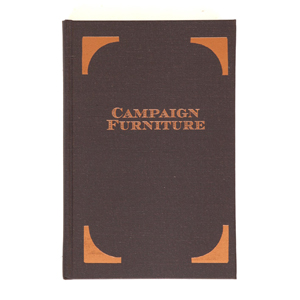
BOOK REVIEW:
Campaign Furniture, by Christopher Schwarz
by J. Norman Reid
Delaplane, VA
To be frank, I wasn't at all sure I'd like this book. To me, campaign furniture seemed out of the mainstream, obscure even, and if not freakish certainly a sideshow. But now that I've read the book, I've concluded that though campaign furniture may be a bit of an acquired taste, it is certainly a delectable one. In the end, I've come to admire this too much overlooked style, which Schwarz correctly states fits in nicely with many other periods of furniture. And I loved the book.
The campaign furniture style was most closely associated with the once-expansive British Empire's continual need to send soldiers and administrators to the four corners of the earth. Distant travel and frequent relocation created the need for practical furniture that was easily and securely transported and yet both functional and attractive upon arrival. As a result, campaign furniture was in widespread use throughout the 19th century and up to World War II, after which it tended to disappear from sight outside of auction houses and antique stores.
Interestingly, the campaign furniture style, with its clean lines and practicality, had influence far beyond its own confines. It informed such 20th-century designers as Kaare Klint, who borrowed the Roorkee chair as the model for his famous "Safari Chair," Marcel Breuer ("Wassily Chair"), La Courbusier ("Basculant" chair), Wilhelm Bofinger ("Farmer chair"), Arne Norrell ("Sirocco" chair), and Vico Magistretti ("Armchair 905"). Other illustrations abound; think Army cots and beach chairs, among others.
Schwarz's book is one of very few sources on campaign furniture and the first of its kind. The opening chapter briefly reviews the history of the style and the range of pieces in common use. It provides a good orientation to the principal features of the style. But after these preliminaries, the bulk of the volume is given over to the construction of eight pieces representative of the principal types of campaign furniture. These are a campaign chest, campaign secretary, folding camp stool, Roorkee chair, strong trunk, field desk, collapsible bookshelves and a traveling bookcase.
Each of the chapters on construction addresses wood selection options and provides construction details in enough depth for intermediate and advanced woodworkers to build their own pieces, either replicas of those in the book or their own variations. Each chapter includes scale drawings and a cut list. Most attention is focused on the unique aspects of building each piece. In-depth discussions of issues covered in earlier chapters are often not repeated in full detail in later ones, so a complete reading of the book is recommended. The biggest challenge for most pieces is the installation of flush hardware, which Schwarz reports requires the largest share of time in building campaign furniture pieces. He describes these procedures in good detail.
An early chapter addresses the types of wood used in original pieces of campaign furniture. Teak was once one of the most common; at the time it was relatively cheap because supplies were thought to be inexhaustible. Today, teak and other species such as camphor and padauk are less available. But other species now more available–quartersawn white oak and walnut, for instance–are also appropriate to the period. In a later chapter Schwarz expresses regret for having built some of his demonstration pieces from exotic woods, a practice he ordinarily shuns. In the end, he urges woodworkers to choose walnut, which is plentiful in North America as well as appropriate to period pieces of campaign furniture.
The book concludes with several appendices: a fresh translation of a short section on campaign furniture by Roubo, a quaint 1910 essay on Indian joiners by George Cecil, a large selection of etchings of campaign furniture pieces reprinted from the British Army & Navy Store's catalog and a listing of some sources of hardware for campaign furniture.
As I said earlier, while I was tempted to pass up this book, I'm very glad I didn't. I came to like it a lot. It is, as we've come to expect from Schwarz, informative, clear and entertainingly written. The book is well-illustrated throughout with photos that convey the essence of critical construction steps. It is hard bound and printed on high quality paper, something that's usual for books from Lost Art Press, which makes this one a definite keeper.
Students of furniture styles will find this book of great interest, as will woodworkers who wish to build pieces of their own. I not only enjoyed reading this book but I also learned a lot about both the style and construction techniques. I can easily recommended it to armchair woodworkers looking for a good read, woodworkers seeking to build their skills by taking on new challenges and those who'd like to add these stylish and practical pieces to their own homes or offerings for sale.
CLICK HERE to purchase your own copy of
Campaign Furniture
The author is a woodworker, writer, and woodworking instructor living with his wife in the foothills of the Blue Ridge Mountains with a woodshop full of power and hand tools and four cats who believe they are cabinetmaker's assistants.
He can be reached by email at
nreid@fcc.net
.
Return to
Wood News
front page


